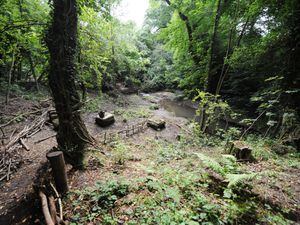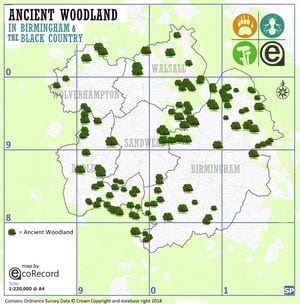Ancient Black Country woodlands face threat from development, campaigners warn
Ancient woodlands in the Black Country face a stark threat from pollution and intruding building developments, environmental campaigners have warned.

These woodlands have colonised the region for thousands of years and are home to rare plants and animals which are found “nowhere else”.
But with the Black Country getting ever more crowded as the region’s population continues to grow, some of these natural habitats are at risk of damage.
Simon Atkinson, conservation manager at The Wildlife Trust for Birmingham and the Black Country charity, said: “The most obvious threat is from development, as despite a special mention in national planning guidance they are not automatically protected.
“Current examples of this in the West Midlands include HS2, the route of which is going through a number of ancient woodlands – including at one of the Wildlife Trust for Birmingham and the Black Country’s nature reserves, Park Hall, in east Birmingham. ”
There are around 87 ancient woodlands spread across the four Black Country boroughs, according to EcoRecord, a biological record centre based in Birmingham.
These are found in nature reserves, country parks and nestled within heavily built-up areas.

Ancient woodlands are defined as areas which have been continuously wooded since the 1600s, said Andy Slater, from EcoRecord.
“These places are irreplaceable habitats, which take hundreds of years to develop and support a range of plants, fungi, insects and birds found nowhere else,” said.
The woodlands in the Black Country date back before the industrial revolution, and long before the region was densely populated as it is today. One of them is Saltwells Nature Reserve in Netherton, Dudley, which was recently under threat from a controversial housing development.
Plans were lodged to Dudley Council in October for nine homes, which would cut an acre out of the nature reserve, but planning bosses refused them after a huge public backlash.
What also poses risks to woodlands is a more obvious factor: pollution, which is caused by car fumes, fly-tipping and waste products from heavy industries.
Mr Atkinson said: “Many ancient woodlands contain some of our most natural streams which haven’t been modified and straightened as they often have elsewhere.
“These provide habitat for a wide-range of specialist insects and the birds that feed upon them, but often pollution from roads, homes and businesses can leak into streams and have a devastating impact.
“Perhaps the least well-known type of pollution that damages sensitive habitats such as ancient woodlands is nitrogen, which is released into the air from car exhausts, industry and farming.
“Nitrogen over-fertilises soils which leads to plants such as nettles and bramble becoming rampant, pushing out woodland wildflowers and all the wildlife that depends upon them. Even more unsightly than dumped garden waste is litter and fly-tipping. Sadly this is increasing in ancient woodlands, just as elsewhere, and can be very damaging to wildlife.”
Another threat posed to the Black Country’s ancient habitats is foreign plant species. Species native to English woodland can include wild flowers like dog’s mercury, wood anemone and wood millet. But plants from other countries can cause mayhem if they end up in native environments.
Mr Atkinson continued: “Many more ancient woodlands in the Black Country are suffering less obvious damage.
“These woodlands are part of historic rural landscapes and as such are comprised of native trees and plants which have colonised over many hundreds – and in some cases thousands – of years. This has created a unique type of habitat which is home to a wide-range of woodland flowers, insects and other animals.
“Being close to modern gardens has meant that many other plants have spread into the woodlands – either on their own or having been introduced through the all-too-common practise of dumping garden waste.
“This not only changes the woodlands’ historic character but some plants can out-compete the native species leading to them diminishing.
“Arguably the most damaging of these is the garden hybrid of Spanish and English bluebell which can potentially lead to the loss of the traditional carpet of bluebells that so many people love.
“There are many other garden plants such as rhododendron, cotoneasters, variegated yellow-archangel and cherry laurel which are also very common colonisers; and there are also trees including sycamore and Norway maple which can very quickly take over the canopy and shade-out the woodland flowers.”
Tell-tale signs of ancient woodlands can be bluebell flowers on the floor, old trees with large trunks ,and ancient boundary banks and ditches.
Ancient woodlands in the Black Country range from Saltwells, the region’s largest; to Sot’s Hole in Sandwell Valley Nature Reserve; Waterhead Brook in Northycote Country Park, Wolverhampton; and Merrion’s Wood, on the border of Great Barr.
Others include Alder Coppice, off the Northway road in Sedgley; Ham Dingle, Pedmore; Furnace Coppice, on the banks of the River Stour in Hawne, Halesowen; Cuckoo’s Nook, off the Sutton Road, Walsall.
There are also tiny pieces of woodland dotted around the region especially Sandwell.
To find out about the Black Country’s ancient woodlands, visit www.bbcwidlife.org.uk





